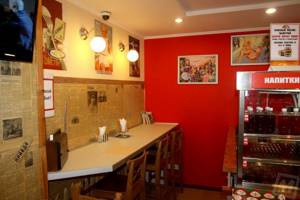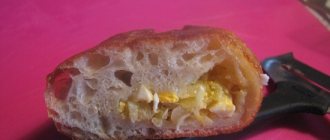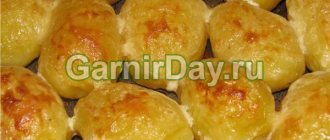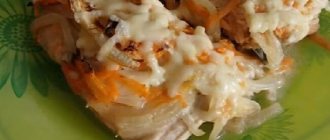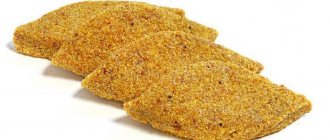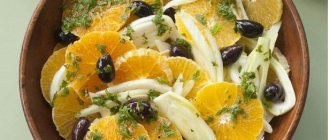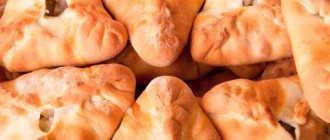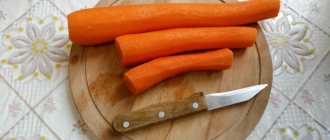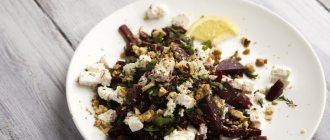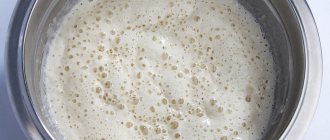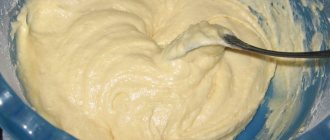Pasties with fish - step-by-step recipe with photos on Povar.ru
Description of preparation:
Do you want variety in your home kitchen?
Then prepare fish chebureks, which turn out no worse than meat ones. It’s very easy to do, watch the step-by-step recipe and cook with pleasure! Prepare your ingredients.
Sift the flour into a mixing bowl, make a well in the flour, and pour a glass of boiling water into it.
Whisk 1 egg, add a pinch of salt, add vegetable oil, mix everything.
Add the butter-egg mixture to the flour.
Knead the dough, knead until smooth and homogeneous. Transfer the dough into a plastic bag while you prepare the minced fish.
Clean the fish from bones and skin, prepare the minced meat with onions, add salt and pepper, beat 1 egg into the minced meat, stir well.
Make a sausage out of the dough, cut into pieces, roll out the dough into a thin layer, there is no need to add flour when rolling out the dough, the dough is very elastic and rolls out very easily. Place minced fish on half of the dough.
Cover with the other half of the dough, trim the edge with a curly knife, and seal the edges of the dough well.
Prepare all the pasties for frying in the same way.
Fry the pasties on both sides in a well-heated frying pan in vegetable oil until golden brown.
Serve fish pasties hot, but they are also very tasty cold. Try it, you won't regret it!
Who invented the cheburek?
Naturally, this dish is quite ancient, rooted in the intricate, complex history of Central Asia. So there is a lot of controversy around chebureks.
The Uzbeks seem to be considered the inventors, but their original recipe did not contain meat at all, only vegetables. And the dough was a little different: flour, salt and water. It did not become crispy, but stretched like rubber.
The primacy of the Uzbeks is disputed by the Tatars. Their strong point is the traditional meat filling. But chebureks are not very popular in Tatar cuisine. Whitefish are the first to come to mind. And by the way, the traditional cheburek actually resembles a pie in size: huge and round. It was an integral part of feasts, celebrations and family dinners.
And the cheburek that we know now is its mini version, adapted for snacking on the go.
Minced fish
Minced fish
Introduction What is minced fish? How a bone separator works Advantages of minced meat Disadvantages of minced meat Preparing fish for a meat grinder Working as a separator Keeping quality of minced meat Rules for handling and storing minced meat Sensory properties of minced meat Disposal of minced meat
Introduction
This note applies primarily to minced meat produced when the fish flesh is separated from the skin and bones in a bone separator. The advantages and disadvantages of minced meat are discussed, tips are given on preparing fish for grinding, the use of a bone separator, and the transport and storage of minced meat. The quality of the mince is compared with that of other types of fish, and there are some comments about how the mince can be fully utilized.
What is minced fish?
The most common method of separating the edible flesh from the waste is by filleting, but it is possible to obtain more pulp in the form of coarse mince by putting either raw fish or the waste left over from filleting through a bone separator.
How does a bone separator work?
There are bone separators operating on different principles commercially, but the most widely used type for fish is a relatively simple design. Fish or pieces of fish are loaded from a hopper to pass between a moving rubber belt and the outer surface of a rotating perforated stainless steel drum. The flesh is pushed through the perforations into the drum, from where it is expelled as coarse mince by a fixed auger. The skin and bone are left on the outside of the drum and are continuously removed by a scraper blade. Perforation drums usually have a diameter of 5 mm, but drums with smaller or larger holes have holes from which minced meat of different textures is obtained. Profitability can be increased by increasing the tension of the belt, due to a slight increase in the degree of crushing of the pulp, as well as in the number of bones, pieces of skin and the black lining of the abdominal wall.
Benefits of minced meat
The overall yield of low-bone meat is higher only with filleting; twice as much can be obtained by separating the pulp directly from gutted headless fish. When the fish is first filleted, an additional 8-12% of the pulp can be separated from the fillet waste.
Some people don't like fatty fish, such as herring, and this is partly due to the large number of small bones left in the fillet; mince from these fish is relatively boneless and may therefore be more palatable. The flesh of underexploited species such as blue whiting, which is difficult to fillet due to its small size or awkward shape, is easily removed in a bone separator.
Grinding allows for better control of flavor, appearance and shelf life through additives. For example, rancidity in oily fish is easier to control when minced. pulp by thoroughly mixing with approved antioxidants or minced meat from different fats, the contents can be mixed to obtain a more desirable result. Minced meat can be cast into a variety of shapes and is suitable for continuous production methods.
Disadvantages of minced meat
When grinding fish meat, the texture, taste and sometimes also color are changed; hence minced fish and products derived from it now have only limited retail outlets. Small quantities are used in fish cakes and in less expensive varieties of fish stick, and some are used to fill voids in frozen laminated fillet blocks from which they are cut into portioned portions and fingers. The current market for minced meat is small compared to the volume of minced meat that may be available from all suitable types.
Minced meat spoils more quickly than fillets of the same material, mainly because the structure of the flesh is destroyed when separated, and the excess must be maintained to maintain good quality; in particular, the fish used for minced meat must initially be of very high quality, and processing must be completed quickly.
Preparing fish for minced meat
Whole white fish, such as cod and haddock, should be gutted and topped. In addition, the area of the spine directly above the abdominal cavity. should be removed; otherwise, blood along the spine will cause discoloration and spoilage of the minced meat, and large pieces may damage the rubber separator band. Fillet trimmings can be fed directly into the separator. All oily fish should be gutted and headed and then separated to allow them to pass through the separator more easily. Soft-skinned species should be skinned. before passing them through the separator; otherwise too many skin fragments will pass through the mince.
All fish or trimmings being prepared for separation should be rinsed to remove adhering debris and drained before entering the machine.
Mixed substances should not be passed through a separator unless it is known that there is no adverse interaction; otherwise there is a risk that enzyme activity may lead to chemical changes that result in an unacceptable texture.
Work separator
The separator must be cleaned and cooled before use and at intervals during use; Feeding flake ice through the machine during operation, followed by rinsing with a high-pressure hose, is a simple and effective cleaning and cooling procedure. If the machine becomes clogged during operation, it should be disassembled, a fairly simple task, and the parts should be washed thoroughly with a hose.
Regular lubrication is necessary; The machines are equipped with grease nipples and suitable food grade lubricant must be injected through them. every few hours when using the machine daily.
Fish can be fed randomly from the hopper to the separator. method, but performance can be improved by placing the fish skin-side against the belt and the cut surface of the meat against the drums; The skins are removed cleanly, the separator is less clogged, and the minced meat is less likely to contain flakes and pieces of skin.
Keeping quality of minced meat
Hygienic minced meat has the same original quality as the raw materials from which it was made; when the mince is made from fresh white fish, the fillet makes the best mince, followed by the fillet trimmings, frames or skeletons from which the fillet is cut, and only the ridges in this in descending order of quality. Mince from stale fish is bad, no matter what the parts of the fish are used.
Minced cod fillets from 4 days of aging have an unacceptably high bacterial count after 24 hours of storage at 5-10°C. Minced meat made from 12-day old cod fillets has a high initial count, which changes slightly when stored for 24 hours. Therefore, minced meat should be made only from fresh raw meat. material quickly and hygienically processed and then frozen.
Handling and storage of minced meat
Minced meat should be frozen immediately after it is prepared or added to foods, and then frozen within 4-5 hours of production; Food must be kept refrigerated while waiting to freeze.
Minced meat can be frozen in blocks in cardboard boxes on a horizontal plate. freezer in the same way as for glued fillet blocks.
The shelf life of frozen good quality cod mince and haddock meat is at least 6 months at -30°C or 3 months at -20°C, without significant loss of quality, but some fish, especially hake and pollock, have been found to have a shorter shelf life shelf life in the refrigerator. All types of minced meat that include part of the active tissue of the spine and intestines will also have a reduced shelf life in the refrigerator. Minced meat washed with water holds better than unwashed minced meat, and minced meat with additives such as sucrose or sorbitol holds better than minced meat without additives. Minced fatty fish require protection from oxidation when stored in the refrigerator.
Sensory properties of minced meat
The appearance and texture of mince differs from fillets because the flesh is fragmented, but limited testing has shown that consumers are not overly put off by the unfamiliar appearance of mince when presented in fish sticks, provided they are made from fresh stock; indeed, in taste tests, children clearly preferred fish sticks made from mince rather than fillets.
There is some loss of the fresh fish's sweet flavor during grinding and, more seriously, there can sometimes be a slight "cardboard" taste. found to be more commonly associated with refrigerated storage of whole fish. There may also be a slight increase in hardness and dryness.
By including blood-rich tissue from under the spine among the raw materials, the resulting minced meat will be red in color; minced meat turns brown when cooked and has an unacceptable and sometimes extremely undesirable metallic aroma.
Bone separators do not remove all pieces; The table shows the typical average bone content of minced fish using a 5mm drum.
| Kinds | Piece of fish | Bone weight mg/kg minced meat |
| cod | Fillet | 84 |
| Trimmings | 272 | |
| Framework | 1736 | |
| Backbone networks | 4050 | |
| Herring | Divided fish | 2610 |
Some bone remains in minced meat from fillets or gutted whole fish are needle-shaped and sometimes more than 6 mm in length, which exceeds some bone limit specifications. Bone particles in minced meat from carcasses, that is, the skeletons of whole fish from which the fillet was made, are removed, but still carrying some pulp, dull and irregularly shaped; they will meet the specification that the bones should not be capable of penetrating the soft palate, but may not meet the specification that limits the permitted weight of the bone present. Using a drum with smaller holes reduces bone content, but also produces a mince of poorer texture; Perforations from 1 to 7 mm are available commercially, but a 5 mm drum usually offers the most reasonable compromise.
Using minced meat
Existing applications are the production of fish cutlets, as a filler in laminated fillet blocks with a minced meat content of up to 15%, and for the production of cheaper fish sticks and portions.
It is possible to prepare deep-frozen dishes. from minced meat. The fatty minced fish can be used to create a range of flavorful fish fingers. products by adding a suitable sauce, such as tomato, curry, mustard or cheese. Minced meat is also suitable for making special products such as Gefüllte. Fish: Experimentally prepared minced blue whiting was found to be suitable for preparing surimi and kamaboko, two important Japanese fish products; valuable UK export trade could emerge to satisfy this market.
Good quality frozen mince in small blocks can be found in the retail market for use from home freezers as an ingredient in home-cooked meals.
Mince allows for significant changes in texture, flavor and appearance, as well as the addition of stabilizers and additives; given creative development and marketing there may be good prospects for introducing a wide range of commercial minced fish food products.
.
Page not found – Joyofbaking.com
Contact Us Privacy Policy Follow Joyofbaking on Twitter Stephanie Jaworski +
Use of materials on all pages in the Joyofbaking.com domain, Joyofbaking.com Facebook Page, @joyofbaking Twitter, Joyofbaking.com RSS feed, Joyofbaking.com and any emails sent from @joyofbaking.com is entirely at the user's risk and their owner, iFood Media LLC. shall not be liable for any damages arising directly or indirectly from use.
This website and its contents are not endorsed or sponsored by the owner of the Joy of Cooking book series or its publisher, Simon & Schuster, Inc.
Content in any form may not be copied or used without the written permission of Stephanie Jaworski, Joyofbaking.com. Students and non-commercial educators may use content without permission with proper credit.
Baking resource on the Internet since 1997
Copyright 1997 to 2012 iFood Media LLC
.
Fish cakes | Etsy
Etsy uses cookies and similar technologies to give you a better experience, such as:
- main functions of the site
- ensuring safe, secure transactions
- secure account login
- remembering account, browser and regional settings
- remembering privacy and security settings
- analysis of website traffic and use
- personalized search, content and recommendations
- helps sellers understand their audience
- , showing relevant, targeted advertising on Etsy
and beyond
For more information, please see Etsy's Cookies & Similar Technologies Policy and our Privacy Policy.
Always in touch
Necessary cookies and technologies
Some of the technologies we use are necessary for critical functions such as security and site integrity, account authentication, security and privacy preferences, internal site usage and maintenance data, and to make the site work properly for browsing and transactions.
On
Personalized advertising
These technologies are used for things like personalized advertising.
We do this with marketing and advertising partners (who may have their own information collected). Opting out won't stop you from seeing Etsy ads, but it may make them less relevant or more repetitive. Find out more in our Cookies and Similar Technologies Policy.
.
“Soviet Cheburek” on Krasina
Here you can already have a full lunch. The menu is not huge. There are a couple of salads, a choice of soup, dumplings and, of course, pasties (with meat, cheese, potatoes and mushrooms).
The cost here is the same as in Druzhba. Price range: 60, 50, 40 rubles per piece depending on the filling. By the way, to be honest, this is how a cheburek should cost in Moscow.
